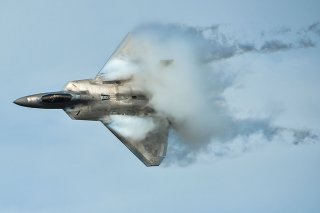Meet Link 16: The Big Communication Upgrade the F-22 Stealth Fighter Just Recieved
A good back up if normal voice comms are hacked during a fight.
Often referred to as an “aerial quarterback,” the U.S. F-22 Raptor is designed as a “first look, first shot, first kill” kind of air dominance fighter intended to ensure air supremacy and, in many cases, establish a safer “air corridor” for less stealthy and maneuverable aircraft to attack.
Now, the stealth fighter will have a safer and more direct way to transmit intelligence data, video-sharing, targeting information and other combat essential communication through a TACLink 16 data-exchange enabling non-radio or voice connectivity between aircraft in war.
LINK 16, an established and well known datalink, will enable an F-22 to receive and ultimately send information to F-35s, F-16s, F-15s and others without needing to rely upon voice communication. One senior Lockheed official explained it by saying that LINK 16 can ensure warfare networking between attacking aircraft in the event that radio encryption was hacked, disabled or somehow compromised by an enemy. This means that if a forward-operating F-22 encountered 5th-gen enemy fighters or advanced air defenses, yet in an environment without radio communication, the pilot would still be able to send warning information and even sensor data to other aircraft potentially moving toward a lethal encounter.
This is made possible through a series of software upgrades to the F-22 known as Update 6, according to Lockheed Martin developers.
“Update 6 is a software/firmware release that provides new aircraft cryptographic algorithms for Intra-flight Data Link, Link-16 interoperability and secure UHF radio communications. The configuration also includes several improvements to the Pilot Vehicle Interface,” Lockheed spokesman John Losinger told The National Interest in a written statement.
Two-way LINK 16 data sharing is still on the way for next year, however Update 6 brings “receive” information to the F-22. In this instance, a forward operating drone or other surveillance node could identify enemy targets and send the data back to an attacking F-22.
Update 6 also includes several weapons upgrades for the F-22, a fighter the Air Force plans to keep operational until 2040 and beyond through a series of ongoing upgrades. Some of these included in Update 6, for instance, include software adjustments for the aircraft’s radar systems. The aircraft is also now being integrated with new variants of significant weapons such as the AIM -9X and AIM 120D.
Newer F-22s have a technology called Synthetic Aperture Radar, or SAR, which uses electromagnetic signals or “pings” to deliver a picture or rendering of the terrain below, allowing better target identification. The SAR technology sends a ping to the ground and then analyzes the return signal to calculate the contours, distance and characteristics of the ground below. The F-22 is also known for its “super cruise” technology which enables the fighter to reach speeds of Mach 1.5 without needing to turn on its afterburners. This allows the fighter to travel faster and farther on less fuel, a scenario which expands its time for combat missions. The fighter jet fires a 20mm cannon and has the ability to carry and fire all the air-to-air and air-to-ground weapons including precision-guided ground bombs, such Joint Direct Attack Munitions called the GBU 32 and GBU 39.
It also uses what’s called a radar-warning receiver—a technology with an updateable database called “mission data files” designed to recognize a wide-range of enemy fighters, much like the F-35. The aircraft was first introduced in December of 2005; the F-22 Raptor fighter jet delivered some of the first strikes in the U.S.-led attacks on the Islamic State in Iraq and Syria, when aerial bombing began in 2014.
After delivering some of the first strikes in the U.S. Coalition-led military action against ISIS, the F-22 began to shift its focus from an air-dominance mission to one more focused on supporting attacks on the ground. Made by Lockheed Martin and Boeing, the F-22 uses two Pratt & Whitney F119-PW-100 turbofan engines with afterburners and two-dimensional thrust vectoring nozzles, an Air Force statement said. It is 16-feet tall, 62-feet long and weighs 43,340 pounds. Its maximum take-off weight is 83,500.
Kris Osborn is the new Defense Editor for the National Interest. Osborn previously served at the Pentagon as a Highly Qualified Expert with the Office of the Assistant Secretary of the Army—Acquisition, Logistics & Technology. Osborn has also worked as an anchor and on-air military specialist at national TV networks. He has appeared as a guest military expert on Fox News, MSNBC, The Military Channel, and The History Channel. He also has a Masters Degree in Comparative Literature from Columbia University.
Image: Reuters.

